Loved how the light DMC Petra yarn shows off this pattern to its finest, don't you agree?
I've made this pattern before as a top which you can find here
With this pattern there are so many ideas and possibilities, but with interesting possibilities come some interesting choices and small calculations.
Remember to read all the way till the end of this blog to get all these ideas.
I have worked this pattern using squares and then half squares (or a rectangle) and then another one with just squares and a lacy bit for the front.
I have also given instructions for two types of sleeves (so in case you wondered why the photo on top looked weird, now you know 😁 )
Come along..let’s get this cool Petra jacket done.
In case you have just joined me, know that you can access all of my earlier creations by checking under ‘categories’ on the right hand side of this blog under “Labels”. Then, for your convenience, follow me here or on Facebook, You Tube, Pinterest, Twitter or Instagram.
Check out all my social media handles at the bottom of this blog
Oh, and may I add that the fastest way to find any of my blogs is via Pinterest.
All my blogs can be printed. Find the printer friendly (green) link on the right hand side of this blog. You can also hit Control P (or Command P for Mac) on your keyboard, and the blog will go directly to the connected printer.
Remember that you only print if absolutely essential. Save paper – Save Our Earth.
Do remember to add my blog URL when you make and show off your creation.
Just copy the link on the search bar above - that's the blog URL.
To purchase this or similar yarn online, click here to buy your yarns online via Amazon. While you will still pay the same, I may get paid by Amazon as well.
This is a free blog - so do pay it forward for me. Cheers.
Today’s pattern is made using the granny squares and its a beautiful light lacy pattern. We work as many squares as we need for the length and width of our project
Before we jump into making our squares, let's get a few calculations out of the way.
a) We need round bust, round waist and round hip measurements.
As always, please use the largest measurement for your calculations
b) We also need round armhole and sleeve length if you are making sleeves
c) We need depth of neckline for front & back if you are going to keep them at different lengths / heights
d) Finally as always I suggest you keep a well fitting top that you can use as a draft
e) For advanced crocheters : In case you are using a slightly thicker yarn (and hook), and still want a light lacy project, maybe try using ch-3 sps (instead of ch-5 sp). Do remember that I have worked ch-5 sps, so some of the end joining instructions may not work for you - but as you're an advanced crocheter, you'll know that you need then to work ch 1 + dc to be in the centre of the last ch-3 sp.
We start making the first square and measure the length (well its a square so length or breadth works). That will help us decide how many squares we need to get the half round bust/waist or hip measure.
The length of top is slightly simpler as we just keep working and adding squares till we get the length needed. There is also a chart for how we place our squares to get the finished project. Easy enough. Let's start.
Magic circle : https://youtu.be/ISC39yOqWro
Start Round 1 : with a magic circle and work 4 dc in it ;
(ch 4, 4 dc in the same magic circle) ;
rep (to) 2 more times ;
ch 4 and join with a sl-st to the 1st st.
Round 2 : sl-st into the 1st corner ch-4 sp ;
(4 dc ; ch 4, 4 dc) in the same 1st corner ch-4 sp ;
ch 2, rep (to) in the next corner ch-4 sp :
rep (to) 2 more times ;
ch 2 and join with a sl-st to the 1st st.
Round 3 : dc in the 1st 4 dc ;
ch 4, dc in the corner ch-4 sp ;
(ch 4, dc in the same corner ch-4 sp) ;
*[ch 2, dc in the next 4 dc] ;
rep [to] once ;
ch 2, dc in the next corner ch-4 sp ;
rep (to) once* ;
rep *to* 2 more times ;
ch 2 and join with a sl-st to the 1st st.
Double crochet 4-tog as a decrease stitch : dc 4-tog : Here is an easy video tutorial for working a dc 4-tog over 4 sts at https://youtu.be/WjSNi7ithIU
Round 4 : dc 4-tog over the 1st 4 dc ;
(ch 5, dc in the next dc ; 3 dc in the corner ch-4 sp ;
ch 4, 3 dc in the same corner ch-4 sp ; dc in the next dc) ;
*[ch 5, dc 4-tog over the next 4 dc] ;
rep [to] once ;
rep (to) once* ;
rep *to* 2 more times ;
ch 2 + dc and join with a sl-st to the 1st st.
Note : This combination of ch 2 + dc places you in the middle of the last ch-5 sp. We start right here.
In case you are not comfortable with this finish, please work ch-5 and join with a sl-st. Then turn and work sl-st back in the same last ch-5 sp till you are in the centre of it.
Round 5 : (dc ; ch 3, dc) the 1st ch-5 sp ;
{ch 5, dc in the next 4 dc ;
ch 2, dc in the corner ch-4 sp ; ch 4, dc in the same corner ch-4 sp ;
ch 2, dc in the next 4 dc} ;
*[ch 5, sk next ch-5 sp, rep (to) in the next ch-5 sp] ;
rep {to} once* ;
rep *to* 2 more times ;
ch 5 and join with a sl-st to the 1st st.
Round 6 : dc in the 1st dc ;
(ch 1, dc) in the 1st ch-3 sp ;
*rep (to) once in the same ch-3 sp ;
dc in the next dc ;
ch 5, dc 4-tog over the next 4 dc ;
[ch 4, dc in the next dc ; 3 dc in the next corner ch-4 sp ;
ch 4, 3 dc in the same corner ch-4 sp ;
dc in the next dc] ;
ch 5, dc 4-tog over the next 4 dc ;
ch 5, dc in the next dc ;
(ch 1, dc) in the next ch-3 sp* ;
rep *to* all around ;
ch 5, and join with a sl-st to the 1st st.
Double crochet 3-tog : dc 3-tog : https://youtu.be/qlnqXDB3OUM
Round 7 : dc in the 1st dc ;
*(ch 2, dc in the same dc ; dc in the next dc) ;
rep (to) 2 times ;
ch 2, dc in the same last dc as the last st you worked ;
ch 7, dc in the next 4 dc ;
[ch 2, dc 3-tog in the corner ch-4 sp ;
ch 4, dc 3-tog in the same corner ch-4 sp) ;
ch 2, dc in the next 4 dc ;
ch 7, sk dc 4-tog, dc in the next dc* ;
rep *to* all around
ch 7, and join with a sl-st to the 1st st.
Round 8 : sl-st into the 1st ch-2 sp ;
dc 3-tog in the same 1st ch-2 sp ;
*(ch 4, dc 3-tog in the next ch-2 sp) ;
rep (to) 2 times ;
{ch 5, sc in the next ch-7 sp ;
ch 5, dc 4-tog over the next 4 dc} ;
ch 5, dc 3-tog in the next ch-4 corner sp ;
[ch 4, dc 3-tog in the same corner ch-4 sp] ;
rep [to] 2 times ;
ch 5, dc 4-tog over the next 4 dc ;
ch 5, sc in the next ch-7 sp ;
ch 5, dc 3-tog in the next ch-2 sp* ;
rep *to* all around
ch 2 + dc and join with a sl-st to the 1st st.
Note 1 : This combination of ch 2 + dc once again places you in the middle of the last ch-5 sp. We start right here.
Note 2 : I chose to work the 1st and last dc 3-tog for the corners, in the dc 3-tog from Round 7. This means I only worked two sets of dc 3-tog in the ch-4 corner sp. I preferred this finish.
Note : When I say corner ch-4 sp, I mean the ch-sp that's between the centre two dc 3-tog in each corner. There are four dc 3-tog in each corner, right? So the 2nd and 3rd set and the ch-sp in the middle are the corner ch-sp. Got it?
Round 9 : sc in 1st ch-5 sp ;
(ch 5, sc in the next ch-sp) ;
*rep (to) till the corner ch-4 sp ;
[ch 5, dc 3-tog in the next ch-4 corner sp ;
ch 5, dc 3-tog in the same corner ch-4 sp] ;
rep (to) once* ;
rep *to* all around ;
ch 5 and join with a sl-st to the 1st st.
Fasten off and weave in ends.
This completes one square. Feel free to work as charted.
To join squares use one of the methods given below (under joining methods)
I'd suggest you use the Join-as-you-go joining method
In case the video does not come on, please visit https://youtu.be/zN3ECWTYXBk
When joining with ch-4 sp, you will need to work ch 2 + join to next motif + ch 1 and continue work on the motif you are working on - and I feel this is an uneven join
This gives a neat finish and you are joining the motifs continuously as well
If you decide to change direction of leaf while attaching, ensure that you have it facing the way you want before you start attachment.. It's that simple 😊
Joining methods :
You could also decide to work all the motifs and then use one of these methods to join
Whipstitch to join : https://youtu.be/wZ-9LNzftMA
Invisible join : https://youtu.be/a6XZQ6VzJFM
Single crochet to join : https://youtu.be/6FXoW_47_dI
While you could follow the chart to see how many squares you need, I'd also suggest you measure the square to see that the chart works for you.
Start Row 1 : with a magic circle and work 2 dc in it ;
ch 4, 4 dc in the same magic circle ;
ch 4, 1 dc in the same magic circle. Turn.
Row 2 : dc in the 1st dc ;
ch 2, sk next dc , (4 dc ; ch 4, 4 dc) in the ch-4 sp ;
ch 2, rep (to) in the next ch-4 sp :
ch 2, sk next dc, dc in the last dc. Turn
Row 3 : dc in the 1st dc ;
ch 2, dc in the next 4 dc ;
(ch 2, dc in the next ch-4 sp ;
ch 4, dc in the same ch-4 sp) ;
[ch 2, dc in the next 4 dc] ;
rep [to] once ;
rep (to) once ;
rep [to] once ;
ch 2, dc in the last dc. Turn
Row 4 : dc in the 1st dc ;
ch 2, dc 4-tog over the next 4 dc ;
(ch 5, dc in the next dc ; 3 dc in the corner ch-4 sp ;
ch 4, 3 dc in the same corner ch-4 sp ; dc in the next dc) ;
*[ch 5, dc 4-tog over the next 4 dc] ;
rep [to] once ;
rep (to) once ;
rep [to] once ;
ch 2, dc in the last dc. Turn
Row 5 : (dc ; ch 3, dc) the 1st dc ;
{ch 5, dc in the next 4 dc ;
ch 2, dc in the corner ch-4 sp ; ch 4, dc in the same corner ch-4 sp ;
ch 2, dc in the next 4 dc} ;
*[ch 5, sk next ch-5 sp, rep (to) in the next ch-5 sp] ;
rep {to} once ;
ch 5, rep (to) in the last dc. Turn
Row 6 : dc in the 1st dc ;
(ch 1, dc) in the 1st ch-3 sp ;
ch 1, dc in the next dc ;
ch 5, dc 4-tog over the next 4 dc ;
[ch 4, dc in the next dc ; 3 dc in the next corner ch-4 sp ;
ch 4, 3 dc in the same corner ch-4 sp ;
dc in the next dc] ;
{ch 5, dc 4-tog over the next 4 dc} ;
ch 5, dc in the next dc ;
(ch 1, dc) in the next ch-3 sp ;
rep (to) once ;
ch 1, dc in the next dc ;
ch 5, dc 4-tog over the next 4 dc ;
rep [to] once ;
rep {to} once ;
ch 5, dc in the next dc ;
(ch 1, dc) in the 1st ch-3 sp ;
ch 1, dc in the last dc. Turn
Row 7 : dc in the 1st dc ;
(ch 2, dc in the same dc ; dc in the next dc) ;
rep (to) once ;
ch 2, dc in the same last dc as the last st you worked ;
ch 7, dc in the next 4 dc ;
[ch 2, dc 3-tog in the corner ch-4 sp ;
ch 4, dc 3-tog in the same corner ch-4 sp) ;
ch 2, dc in the next 4 dc ;
ch 7, sk dc 4-tog, dc in the next dc ;
rep (to) 3 times ;
ch 2, dc in the next dc ;
ch 7, sk dc 4-tog, dc in the next 4 dc ;
[ch 2, dc 3-tog in the corner ch-4 sp ;
ch 4, dc 3-tog in the same corner ch-4 sp) ;
ch 2, dc in the next 4 dc ;
ch 7, dc in the next dc ;
rep (to) 2 times. Turn
Row 8 : dc in the 1st dc ;
ch 2, dc 3-tog in the next ch-2 sp ;
(ch 4, dc 3-tog in the next ch-2 sp) ;
{ch 5, sc in the next ch-7 sp ;
ch 5, dc 4-tog over the next 4 dc} ;
ch 5, dc 3-tog in the next ch-4 corner sp ;
[ch 4, dc 3-tog in the same corner ch-4 sp] ;
rep [to] 2 times ;
ch 5, dc 4-tog over the next 4 dc ;
ch 5, sc in the next ch-7 sp ;
<ch 5, dc 3-tog in the next ch-2 sp> ;
rep <to> 3 times ;
rep {to} once ;
ch 5, dc 3-tog in the next ch-4 corner sp ;
[ch 4, dc 3-tog in the same corner ch-4 sp] ;
rep [to] 2 times ;
ch 5, dc 4-tog over the next 4 dc ;
ch 5, sc in the next ch-7 sp ;
<ch 5, dc 3-tog in the next ch-2 sp> ;
rep <to> once ;
ch 2, sk last dc 3-tog, dc in the last dc. Turn.
Note : Remember that you may have worked only two sets of dc 3-tog in the corner ch-sps and worked two sets of dc 3-tog in the sts from Row 7 IF you copied my idea when working the squares
Once again, remember the Note just before Round 9 about which is the corner ch-sp.
Also remember that when working this last round, we are joining to the front of the jacket. This is especially if you are working the Join-as-you-go method.
Please remember to join in the same way as you have thus far.
The flat edge is the centre front of the jacket.
Row 9 : dc in the 1st dc ;
ch 5, sc 1st ch-5 sp ;
(ch 5, sc in the next ch-sp) ;
rep (to) till the corner ch-4 sp ;
[ch 5, dc 3-tog in the next ch-4 corner sp ;
ch 5, dc 3-tog in the same corner ch-4 sp] ;
rep (to) till the next corner ch-4 sp ;
ch 5 and dc in the last st.
Fasten off and weave in ends.
We will join at all points - and we have ch-5 sps all around - so its simple.
Work ch 2 ; join to the next motif ; ch 2 and continue to work back on the motif you are working on.
This is why I preferred the ch-5 sp all around.
Border pattern :
You could choose to work this pattern around the neckline, armhole as well as base of top if you wish OR you could leave it with a row of sc for a neat finish.
If working a sc finish, then remember to work 2 sc along each horizontal bar of dc all around.
How to work a picot stitch : Traditionally for a ch-3 picot, you work (ch 3, sl-st in 3rd ch from hook). For a ch-5 picot, you will do (ch 5, sl-st in 5th ch from hook).
Row / Round 2 : sc in the 1st sc ;
Sleeve ideas
For the sleeves, there are two ideas you can work on.
1) Work the same motif pattern and join it to the armhole opening. (left sleeve in photo)
2) Add a lacy finish to match the front lapel (right sleeve of photo)
For the motif, you need to work a half square or rectangle (or full square if you want it longer) and then attach it to the end of the armhole
For the lacy finish, I'll suggest working ch-5 sps all around and continue working ch-5 sps till you get the length you need for your sleeve.
Along the edge of the sleeve, I'd then work the same border as I'd work along the front lapels of the jacket.
Try it and let me know what you think.
If you're visiting me here for the first time, and have liked the experience, do add me to your mailing list (for your convenience) , and all my future free patterns will come straight to your mail box.
It is sad that though my blogs are very popular and being used by so many, not many think of giving credit when you post your projects on social media.
There is a lot of work that goes into writing one of these patterns, so do pay it forward – good karma and all that blah 😄


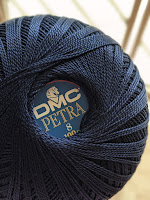
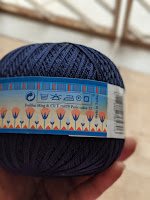
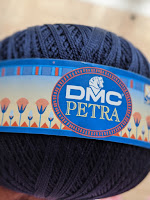
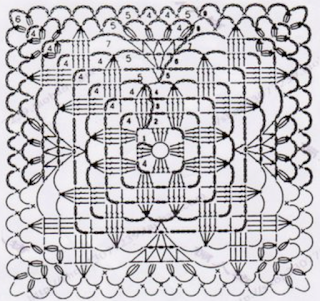
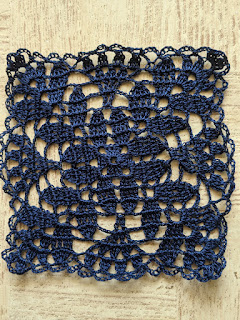



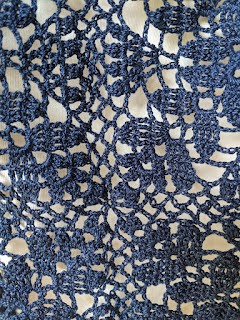


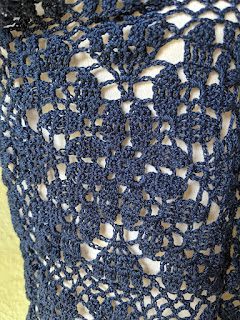

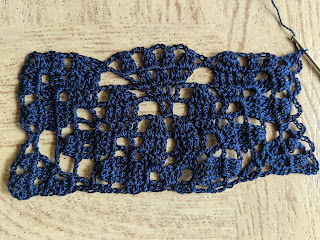







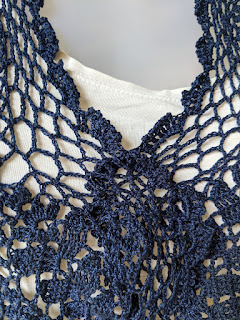





No comments:
Post a Comment
Thanks for taking the time to stop by. Do tell me what you think. Cheers